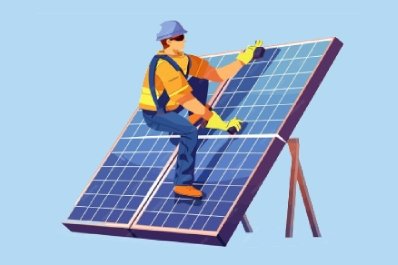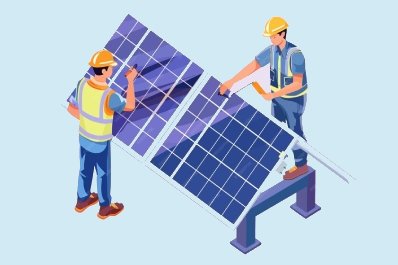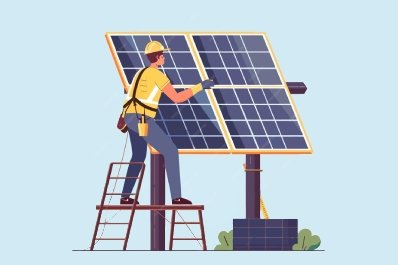a. Grid – Tied system
In this type of system, our system will work in conjunction with the grid. Solar power is the primary source of electricity. The electrical grid supplies power during night and cloudy days. The inverter shuts down the system during power failure.
b. Off – Grid system
In this type of system, battery backup or diesel generator is present. The system works independent of the conventional grid. Using the inverter, the battery backup or diesel generator powers the load during night and cloudy days.
There are two basic components:
Solar array: Ten to Hundreds of kilowatts of solar panels, typically mounted on unused south facing roof space.
Inverter: Converts solar energy (DC) in AC to match utility power. Inverter output is connected to the Grid Panel.(Distribution Box). Priority is set for Solar Power & then for Grid Supply. So your maximum utilization of energy will be from Solar System.
The grid connect inverter will automatically shut itself off within a few milliseconds of a blackout, to avoid the potential of a dangerous “brown-out” in your facility and to prevent back feeding into the grid. Therefore even though you have a solar system during a blackout you will not have power available. If you want to keep on having electricity available during a blackout then you would need to have back up batteries installed as well, which will add to the cost of the system.
The factors to be considered are as follows:
A) Location
Your location determines the amount of solar insolation (sunlight falling on the panel per day). Overall, the location of the rooftop is by far the most important factor that determines the solar power plant output. Location determines the DNI (Direct Normal Irradiance). DNI at a location is the amount of solar energy falling per sqm per day at that location. India has good solar DNI
B) Orientation
A system with solar panels facing in a southerly direction will generate far more than one with a northerly aspect. However, east/west installations can be a good option depending on the installation scenario.
C) Panel Efficiency
Efficiency of the panel is calculated as ratio of capacity of the panel (kWp) with respect to the size (area) of the panel (m2), expressed as a percentage. The efficiency of the panels matters where the rooftop space is limited. As the lower efficiency panels occupy a greater area than higher efficiency panels, we will be able to install fewer panels in the same size roof. Fewer panels mean lower plant capacity, and therefore lower power output from the plant
D) Ambient Temperature
Solar panel temperature is an often ignored but critical parameter in a hot country like India. Though it might seem counter-intuitive, solar PV panels generate less power in very hot summers as the heat reduces their efficiency (the voltage reduces). In Chennai, the month of January delivers better output than May.
| System size | 50 kWp | 100 kWp | 200 kWp | 300 kWp | 500 kWp |
|---|---|---|---|---|---|
| Area required (sq. feet) | 5000 | 10000 | 20000 | 30000 | 50000 |
| Annual generation | 75,000 | 1,50,000 | 3,00,000 | 4,50,000 | 7,50,000 |
| Yearly savings @ Rs. 11.15/unit | 8,36,250 | 16,72,500 | 33,45,000 | 50,17,500 | 83,62,500 |
| Yearly CO2 emissions avoided(kg.) | 87,390 | 1,74,780 | 3,49,570 | 4,48,950 | 7,48,250 |
| Outright Purchase | Solar Lease/PPA | |
|---|---|---|
| Cost savings | Levelised cost of solar is as low as ` 5/unit. Cheaper than both grid electricity and PPA model | PPA’s are signed for 20 years at a price of about ` 7-8 /unit which is cheaper than grid electricity but higher than outright purchase. |
| Payback period | Payback period – 5-6 years plus free electricity for a period of 20 years | Requires long term payment and the owner pays up to 2-3 times more than the cost of rooftop system. Sometimes it requires end of term buy out contract, new contract or system removal fees |
| Upfront cost | Solar PV systems have high upfront costs | No upfront cost in solar lease agreement |
| Tax benefits/ capital subsidy | Tax benefits/capital subsidy are available to home owner which makes system cheaper | Tax benefits are availed by third party providing system on lease |
| Internal rate of return | Rate of return is higher | Rate of return is lower than in outright purchase |
Following benefits are available for grid-connected solar rooftop plant:
a. MNRE central financial assistance i.e 30% of the benchmark cost for selected categories
b. Accelerated depreciation for industrial and commercial buildings
c. Customs Duty and Excise Duty Exemption
d. 10 years tax holiday
e. Net metering
f. Provision of bank loans as a part of home loan/home improvement loan
g. Loan for system aggregators from Indian Renewable Energy Development Agency at concessional interest rate (9.9% to 10.75%)
h. Loans available up to Rs. 15 crore for renewable energy projects and upto Rs. 10 lakhs for individual loans under priority sector lending
Under the MNRE implemented “Grid-connected Rooftop and Small Power Plants Program”, CFA of 30% of benchmark cost is available for following categories:
a. All types of residential buildings
b. Institutional buildings like schools, health institutions, including medical colleges & hospitals (both public and private), R&D institutions etc
c. All government buildings
d. Social sector like community center, welfare homes, old age homes etc.
Note: Private, commercial and industrial buildings rooftops are not covered this subsidy




Copyright © 2024. All rights reserved.